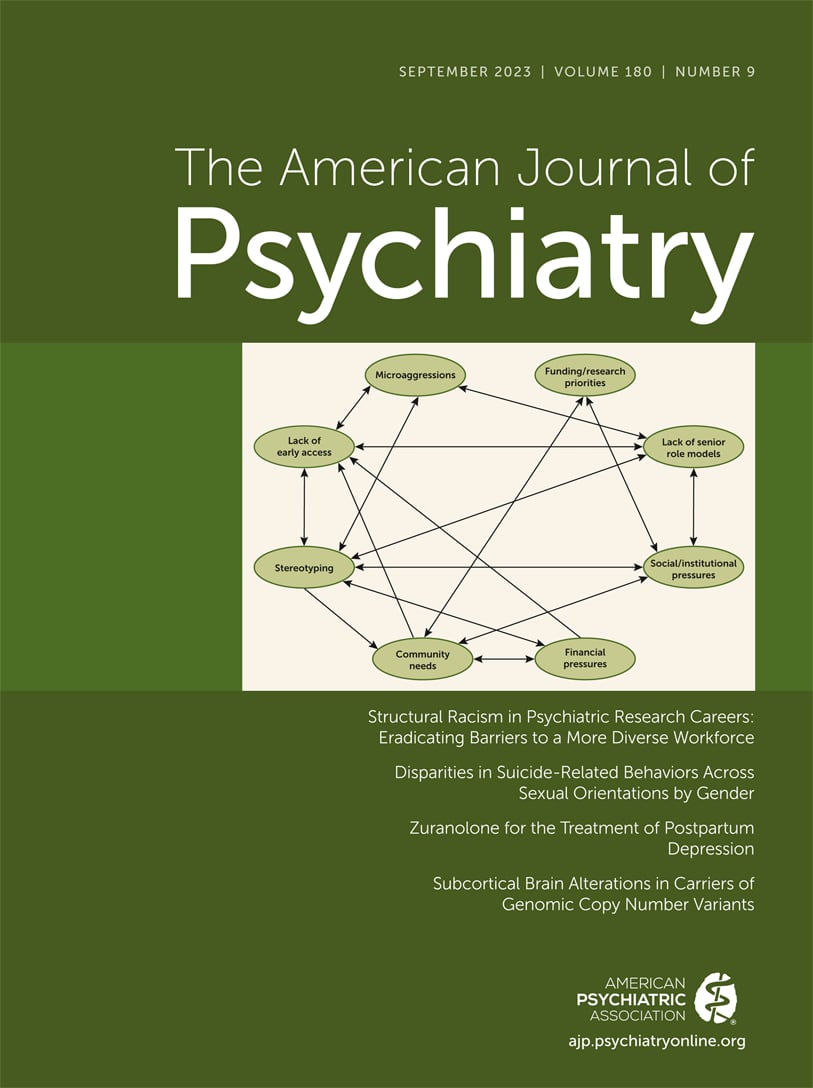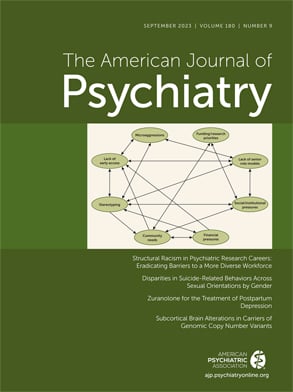Psychiatric disorders are currently classified according to behaviorally defined diagnostic criteria. These categories are invaluable for formalizing a reproducible taxonomy, providing efficient labels for common groupings of complex behavioral syndromes, and aiding communication and treatment decisions, which are often categorical in nature. However, diagnostic categories, which rely on subjective assessments, appear to show relatively weak correlations with underlying neurobiological processes, with many psychiatric disorders showing few reproducible biomarkers (
1,
2). This may reflect the complex interplay between multiple contributing genetic and environmental factors, which often map onto diagnostic outcomes in a pleiotropic many-to-many fashion. Given the limitations of using diagnostic constructs as an entry point to understanding the biology of psychiatric disorders, there has been growing interest in pursuing complementary bottom-up approaches that are rooted in objectively defined risks for psychopathology. One especially powerful form of this approach involves taking a “genetics-first” starting point, by studying groups defined by carriage of highly penetrant genetic variants (
3). Recurrent copy number variants (CNVs) are at the core of this approach.
Recurrent CNVs are deletions or duplications of segments of DNA that occur in the population because of local susceptibilities in the genome to erroneous recombination, and there is a growing list of such CNVs that are associated with an increased risk of developing psychiatric disease. Because these variants are defined by a haploinsufficiency or triplosensitivity of known gene sets, and exert high effect size impacts, they offer some advantages over common variants for studying mechanisms of genetic risk. Moreover—unlike with many rare single-nucleotide risk variants—the incidence rates of CNVs are sufficiently high for research studies to recruit groups of individuals sharing the
same high-effect-size risks and study their biological and clinical effects. These biological signals from genetically defined groups often have larger, more reproducible effects than psychiatric diagnostic groups (
4). Thus, beyond underlying important medical disorders in their own right, CNVs also offer powerful “bottom-up” models of biological changes associated with genetic risk for psychopathology. By pursuing this strategy, Kumar et al., reporting in this issue of the
Journal (
5), generate several important insights into the biological changes induced by high-impact genetic risk for psychiatric disorders and also illustrate some of the remaining challenges for the field.
Substantive New Insights
The study by Kumar et al. is at the cutting edge of neurobiological research into CNVs. It uses sophisticated in vivo measures of brain anatomy to compare the neurodevelopmental impacts of diverse CNVs. Across multiple CNVs, the authors quantify nuanced imaging phenotypes and integrate them to identify their shared and unique biological effects and test how these effects relate to the associated risk for psychiatric diagnoses. Kumar et al. first recover known global associations between CNVs and total intracranial volume, with notably symmetric volume changes for each CNV locus (for example, if intracranial volume is reduced in a deletion, it is increased in the corresponding duplication, and vice versa). Their analyses reveal that each CNV is associated with a patterned volumetric change across subcortical nuclei above and beyond the effect of intracranial volume. Sophisticated shape analyses—investigating changes in the thickness and surface area of these nuclei—show even finer-grained variegation in CNV effects on each subcortical structure, with some dissociations by phenotype and CNV type. Importantly, the study demonstrates that there is a correlation between the anatomical effect size and the risk for psychiatric disorders, which appears stronger when using the finer-grained biomarkers. Finally, some of these neuroanatomical CNV signatures are shown to look like the patterns of disruption seen in psychiatric disorders, but the differential similarity of a CNV signature with psychiatric disorder maps does not seem to predict the differential strength of association between the CNV and psychiatric disorders.
Questions Raised
The work by Kumar et al. and others in this field (
6–
9) has captured multiple gene-brain-behavior relationships in individuals with CNVs, and in doing so, it has shed brighter light on several outstanding challenges in this research space, three of which we consider below.
First, this study highlights how CNVs impact both global and local neuroanatomy, and it remains unclear how best to disentangle the global and local effects in analysis. For instance, what is the most pertinent global metric—intracranial volume, brain size, compartment size—and what is the biological interpretation of findings when looking at absolute or relative size changes of a particular structure? Perhaps more pressingly, how can we establish whether anatomical changes are part of the causal pathway to psychiatric risk?
Second, this study showed that more nuanced structural metrics have greater explanatory power than their coarser counterparts, which illustrates the value of extending beyond more common imaging measures. Extrapolating from this observation highlights the underexplored search space for neuroanatomical biomarkers for uncovering the underlying effects of CNVs on the brain (
10–
13). To address this, we need to maximize the homogeneity and depth of available neuroimaging phenotypes in CNVs, which can be hard to achieve in the large multicenter study designs that are needed to maximize available sample sizes across multiple rare CNV groups. Thus, there is an inherent tension between optimizing phenotyping strategies and sample sizes (perhaps especially so in neuroimaging), which interacts with the choice between single- and multicenter study designs.
Third, as studies by Kumar et al. and others increasingly refine our understanding of altered brain organization in CNVs, they prompt us to reflect on the potential pathways between such findings and improved clinical care. In the medium term, might imaging have incremental utility beyond more readily available behavioral measures in predicting outcomes at the patient level? In the longer term, it is conceivable that resolving the mechanistic basis for regional brain vulnerability in CNVs might identify molecular pathways that can be assayed or manipulated for improved care. It is also possible that common modes of brain alteration across different CNVs might prove to be powerful biological stratifiers of the larger proportion of psychiatric presentations that occur in the absence of a known CNV.
Thus, the Kumar et al. study not only advances our understanding of CNV effects on subcortical anatomy and psychiatric risk but also, in doing so, brings us to a new vantage point from which we can see the landscape to be negotiated in future research. Furthermore, the way in which this work was conducted provides an inspiring blueprint for future work by showcasing what can be achieved by research that is collaborative, creative, and open.

